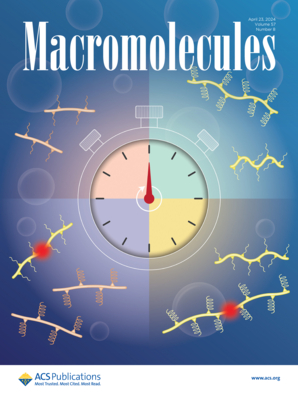Principle of Disentanglement by Intrachain Cross-Linking in the Melt of Soft-Nanoparticles
IF 5.1
1区 化学
Q1 POLYMER SCIENCE
引用次数: 0
Abstract
Polymer entanglements confer exceptional properties, but, at certain conditions, pose significant processing challenges. Disentangled polymers are thermodynamically unstable, leading to ambiguities in their dynamics. The soft nanoparticles (SNPs) may be considered a random coil stabilized by intramacromolecular cross-linking. As a model system of inhibited interpenetration, it could be used to illustrate the disentanglement and shed light on the boundary between polymers and colloids. We bring fractionation to SNPs and systematically curated over forty samples. Terminal relaxation time τ spanning nine decades was quantified while molecular mass spanning as narrow as two decades. Based on the analysis, governing equations for τ were established as functions of bulk diameter (Dbulk) and cross-linking strand length (Nc). We identify the parameter space capable of reducing τ 1000 times, defining the limits of disentanglement. Compared to linear polymers of equivalent molecular weights, lightly cross-linked polymeric nanoparticles exhibit significantly faster relaxation and improved processability. At larger Dbulk and Nc, τ shows a greater divergence than the mechanism of entanglements. Such precise fractionated SNPs are essential for achieving these quantitative insights.

软纳米颗粒熔体中链内交联解缠的原理
聚合物缠结具有特殊的性能,但在某些条件下,会带来重大的加工挑战。解缠聚合物在热力学上是不稳定的,导致其动力学上的模糊性。软纳米颗粒(SNPs)可以被认为是一个由大分子内交联稳定的随机线圈。作为一种抑制相互渗透的模型系统,它可以用来说明聚合物和胶体之间的解缠和边界。我们将分离到snp和系统地策划超过40个样本。终端弛豫时间τ跨越了90年,而分子质量仅跨越了20年。在此基础上,建立了τ的控制方程,作为体直径(Dbulk)和交联链长度(Nc)的函数。我们确定了能够将τ降低1000倍的参数空间,定义了解纠缠的极限。与同等分子量的线性聚合物相比,轻交联的纳米聚合物表现出明显更快的弛豫和更好的可加工性。在较大的Dbulk和Nc下,τ显示出比纠缠机制更大的散度。这种精确的分离snp对于实现这些定量见解至关重要。
本文章由计算机程序翻译,如有差异,请以英文原文为准。
求助全文
约1分钟内获得全文
求助全文
来源期刊

Macromolecules
工程技术-高分子科学
CiteScore
9.30
自引率
16.40%
发文量
942
审稿时长
2 months
期刊介绍:
Macromolecules publishes original, fundamental, and impactful research on all aspects of polymer science. Topics of interest include synthesis (e.g., controlled polymerizations, polymerization catalysis, post polymerization modification, new monomer structures and polymer architectures, and polymerization mechanisms/kinetics analysis); phase behavior, thermodynamics, dynamic, and ordering/disordering phenomena (e.g., self-assembly, gelation, crystallization, solution/melt/solid-state characteristics); structure and properties (e.g., mechanical and rheological properties, surface/interfacial characteristics, electronic and transport properties); new state of the art characterization (e.g., spectroscopy, scattering, microscopy, rheology), simulation (e.g., Monte Carlo, molecular dynamics, multi-scale/coarse-grained modeling), and theoretical methods. Renewable/sustainable polymers, polymer networks, responsive polymers, electro-, magneto- and opto-active macromolecules, inorganic polymers, charge-transporting polymers (ion-containing, semiconducting, and conducting), nanostructured polymers, and polymer composites are also of interest. Typical papers published in Macromolecules showcase important and innovative concepts, experimental methods/observations, and theoretical/computational approaches that demonstrate a fundamental advance in the understanding of polymers.
 求助内容:
求助内容: 应助结果提醒方式:
应助结果提醒方式:


